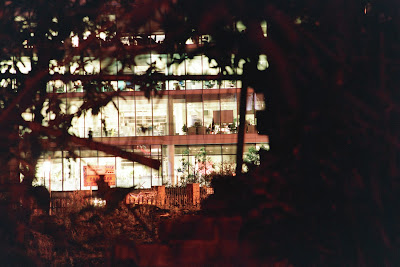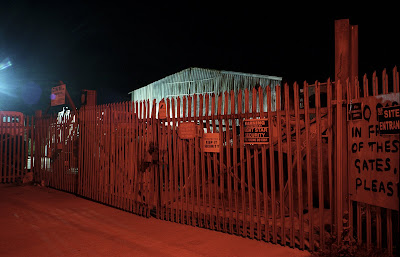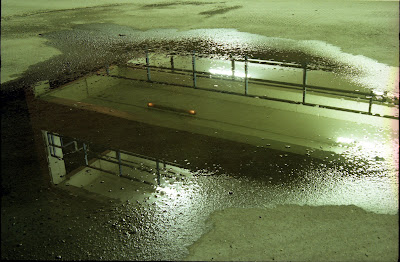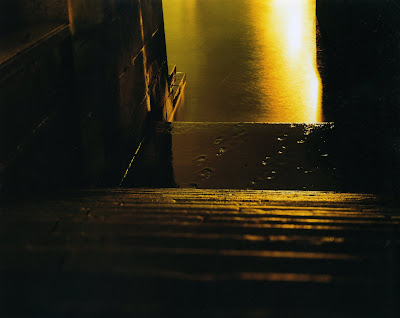Thursday, May 28, 2009
POSITIONING STATEMENT
Within the current climate we love to feel divorced from reality, escapism is alluring and these luminous images give a hint of something that we can imagine to be the future. The use of emanating light and long exposures on film forces the colours into a vivid palette, unseen by the eye this accentuates a further surreal element in the piece and causes us to appreciate each detail of the landscape we once perceived to be mundane.
Tuesday, May 26, 2009
PRESENTATION
Monday, May 25, 2009
FILM 2 (ALL IMAGES © SARAH JANE WALKER)
Sunday, May 24, 2009
HYPERREALITY
In semiotics and postmodern philosophy, the term hyperreality characterizes the inability of consciousness to distinguish reality from fantasy, especially in technologically advanced postmodern cultures. Hyperreality is a means to characterise the way consciousness defines what is actually "real" in a world where a multitude of media can radically shape and filter the original event or experience being depicted. Some famous theorists of hyperreality include Jean Baudrillard, Albert Borgmann, Daniel Boorstin, and Umberto Eco.
Most aspects of hyperreality can be thought of as "reality by proxy." For example, a viewer watching pornography begins to live in the non-existent world of the pornography, and even though pornography is not an accurate depiction of sex, for the viewer, the reality of "sex" becomes something non-existent. Some examples are simpler: the McDonald's "M" arches create a world with the promise of endless amounts of identical food, when in "reality" the "M" represents nothing, and the food produced is neither identical nor infinite.[1]
Baudrillard in particular suggests that the world we live in has been replaced by a copy world, where we seek simulated stimuli and nothing more. Baudrillard borrows, from Jorge Luis Borges (who already borrowed from Lewis Carroll), the example of a society whose cartographers create a map so detailed that it covers the very things it was designed to represent. When the empire declines, the map fades into the landscape and there is neither the representation nor the real remaining – just the hyperreal. Baudrillard's idea of hyperreality was heavily influenced by phenomenology, semiotics, and Marshall McLuhan.
'NIGHT' EXHIBITION AT VIEW FROM THE TOP GALLERY
 1 © Scene Photography
1 © Scene Photography 2 © Scene Photography
2 © Scene Photography 3 © Scene Photography
3 © Scene Photography 4 © Scene Photography
4 © Scene Photography 5 © Scene Photography
5 © Scene Photography 6 © Scene Photography
6 © Scene Photography 7 © Scene Photography
7 © Scene Photography 8 © Scene Photography
8 © Scene Photography 9 © Scene Photography
9 © Scene PhotographyHaving seen this exhibition in March I remembered some very interesting images that were not too far off from my own ideas and so I researched to find the website online (http://www.scenephotography.co.uk/main.php).
Image 3 particularly reminds me of the shots I took on the roof of a cark park shown in the previous post and 8 reminds me of the images I took of reflections in the canal.
Most of these photographs are very impressive but I feel that some are a little cliche, for example numbers 4&6, on the former the light trails possibly feel a little gimicky, I often think, would this picture still look good without the light trails when I see this in an image. As for the latter I'm not keen on the glare from the lights, it looks a little photoshopped to me. Although I particularly like 7 & 9, 7 reminds me of the crossover of nature within the urban landscape and our affects on the environment. In 9 Iparticularly like the way the area is illuminated in the middle and the light falls off towards the edges. This is certainly an intreguing body of work.
Friday, May 22, 2009
FILM 1 (ALL IMAGES © SARAH JANE WALKER)
Images 12 & 13 show the reflection of building work in the river, I like the idea of looking at these places in a different way and the ghost like appearance of the structures but I feel that this would be something that could work as another project in itself.
The top image (1) of the moon over a building site is one of my favourite of this set, the vivid red of the foreground against the deep navy of the sky creates a surreal and eerie feeling. I'm not sure that images 5, 7 &8 work here, I think they look too, 'normal' to fit in with the rest of the photographs and also I don't feel they fit in with my idea.
10 & 11 are another pair that I feel have worked really well these were taken at around midnight on a car park rooftop, I really like the textures and colours within these, the dark violet and lavender in the sky against the acidic yellow of the light on the cubic buildings, I like the simple composition within these and feel that this works really well.
Sunday, May 17, 2009
TECHNICALITIES
As for this 4th Colour layer .... debateable. I just researched what this is supposed to do:
'Fujifilm's 4th Colour Layer Technology delivers exceptionally faithful colour reproduction, even under fluorescent lighting. Thc Colour-sensitive layer enables the films to "see" colour in nearly the same way as the human eye, improving overall colour accuracy'.
Well, I already know that's not true, at least for night shots as it is daylight balanced. I shall use this film anyway, if any problems occur I can always try some others out.
 STATS
STATS'When you want a really fine-grained and natural-looking result under mixed daylight conditions, Superia 200 is the ideal choice. Equally excellent for people shots, capturing skin tones naturally and beautifully, Superia 200 delivers an image sharpness that many 100 ISO films find hard to equal.
- Excellent skin tone reproduction makes this film the perfect choice for natural subjects.
- Refined sharpness for the image quality and clarity you expect from most ISO 100 films.
- Wide exposure latitude brings excellent results from a wide range of daylight conditions.'
Within the urban landscape there are so many areas that appear vapid and are overlooked, yet at night they can be transformed into a place of beauty, the change in lighting, the shadows and reflections all add to this, some shattered glass can be transformed as can potholes filled with water and demolition sites. Through this work I wish to make visible that which often goes unnoticed, to draw attention to the banal through use of various techniques. The products I use will be integral to making this idea all I hope it can be.
Saturday, May 16, 2009
RUT BLESS LUXEMBURG

 Attempt Of Seduction, 1999 © Rut Blees Luxemburg
Attempt Of Seduction, 1999 © Rut Blees LuxemburgMost of her images are gritty night-time views of a depopulated London, illuminated only by the eerie glow of streetlamps. This use of long exposures is a technique I have used within my own work allowing me to use the light emanating from the street only.
Each image in the series depicts an area of the city as a site of menace and as an arena for potential encounter. The lack of human presence makes it difficult to construct narrative content and opens up endless possibilities for the viewer to project questions onto the work. Blees Luxemburg followed A Modern Project with Liebeslied, a series of fourteen photographs taken between 1997 and 2000. These images, subtly influenced by the work of the German poet Friedrich Hölderlin (1770-1843), are more lyrical and abstract; yet still take the forgotten corners of night-time London as their main subject.
One theme that links all of Blees Luxemburg's work is her desire to make visible that which often goes unnoticed. By seeking out hidden spaces, and overlooked, abandoned or even threatening areas of otherwise familiar cities, Luxemburg presents the viewer with a key to understanding the particular nature of the urban environment. A bleak open-air car park for instance, its concrete surface marked with potholes and puddles, bears the trace of past neglect but, at the same time, these marks predict the future threat/promise of redevelopment by reflecting the surrounding office buildings. This place, nothing more than a rough area to park cars, becomes a place with history, a presence and a future.










































